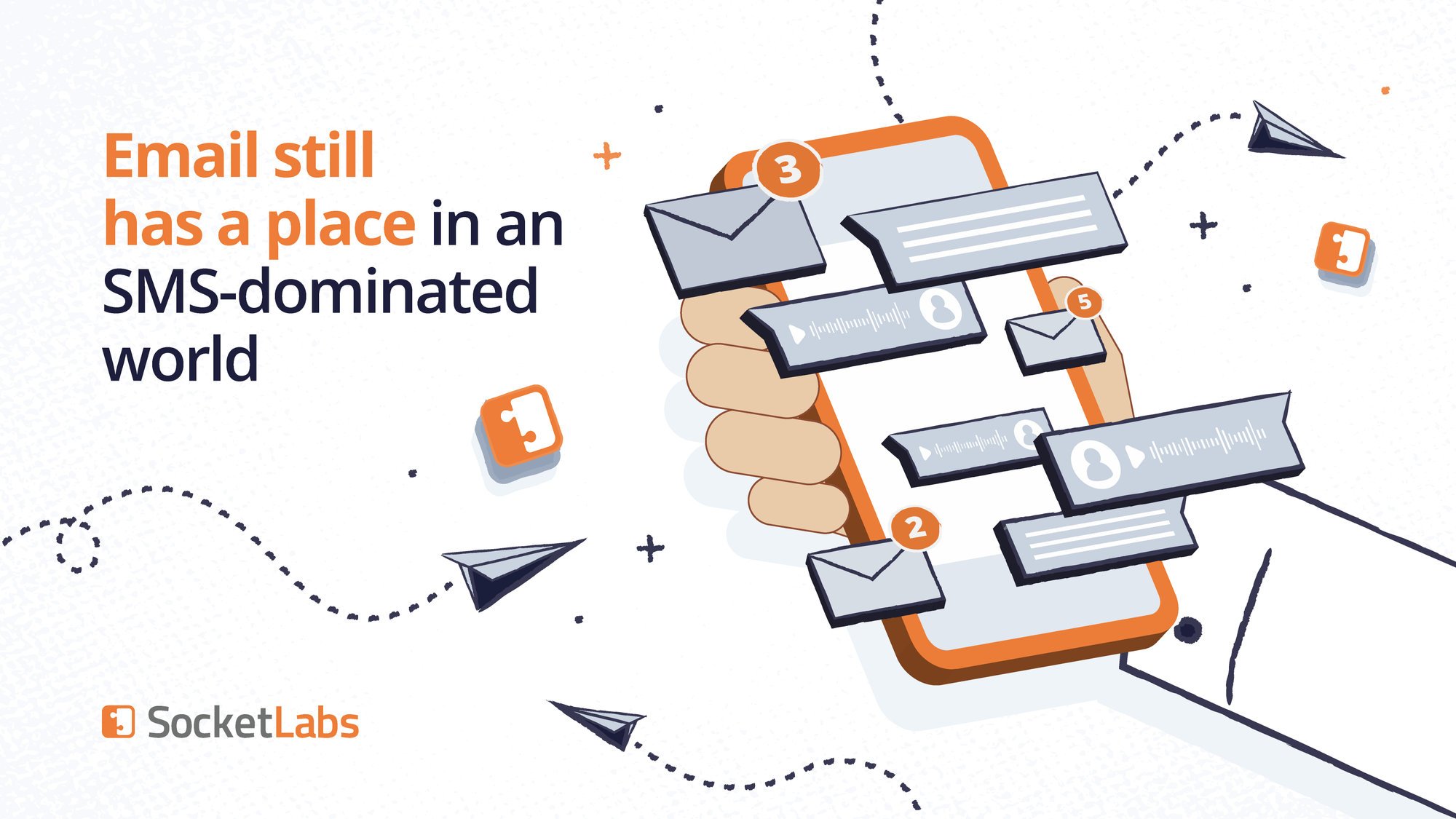
Email is dead and SMS killed it! We have a killer on the loose!
Just kidding.
What’s not a joke is, lots of marketers are looking at SMS right now, wondering if it’s the future of one-to-one communications, and if email is finally terminally ill. Since we all know email isn’t dead (seriously), we shouldn’t be ready to write off email as soon as the newest marketing tool comes along, but for some people, this feels kind of…different.
Lots of factors impact the outsized growth of SMS in the marketing mix today. Maybe your audience primarily works from home and ditched their office phones a couple years ago. Maybe they still have the office number but would rather throw the phone out the window than answer a cold call.
Texts don’t really have that barrier right now. For some, this is a green light to go big and tell email to go home. This is misguided.
Let’s talk about SMS and email with the marketing ecosystem, and why they shouldn’t be considered predator versus prey.
The rise of marketing SMS
First things first: short message service (SMS) is the fancy term for text messages. For brands, it’s another form of direct-to-consumer communication, much like email. There are a bunch of marketing SMS platforms allowing users to insert promotional text and then they’ll deploy it on their behalf, so it’s also very similar to email in terms of execution.
Marketing SMS use cases can vary. Electronic receipts, order confirmations, shipping notifications and the like can be considered transactional SMS, while promo codes, event invitations, and other sales-driving activities can be called promotional.
The data on SMS marketing is super enticing, but it’s important to take it all with a grain of salt. SMS currently boasts estimated open rates at 98% and response rates at 45%, but it seems nobody’s read past the headline, because the corresponding article would quickly tell you it’s impossible to track SMS opens. If you try to compare apples to apples (which you shouldn’t here), these rates admittedly put email to shame. However, there’s a lot more to the story.
Think about your own SMS activity. You might open texts you get from brands, but it’s most commonly to delete them or remove the notifications, not to engage. Some people can tolerate 50 alerts on their phones each day, but…that ain’t me. And I’m pretty sure it’s not you, either. So, open rates aren’t the best metric to use for measuring success within SMS.
Engagement beyond the open is much more important. Klaviyo reports Q1 SMS click-through rates at about 8%. This shows actual intent and is probably a more convincing testament to SMS success. Companies are reporting impressive conversions as well, with Shopify saying, “ecommerce marketers generate around $71 for every dollar spent on SMS.”
Impressive. But SMS is operating at the same level of success email did at the height of its success years ago. Back then, marketers believed if every email campaign generated $20,000, it made sense to send a ton of email campaigns. Why not, right? Wrong.
The concept of diminishing returns means the more times you try the same method, the less effective it becomes over time. Email was a novelty for marketers and consumers at some point, much like how SMS feels today. Plus, all good things have a bad side…spam. The email industry spends a lot of time and money on catching spam, sequestering malicious email, and helping marketers avoid spam folders where legitimate email goes to die.
This is why we can’t have nice things.
SMS spam exists, and the industry will eventually need to combat a rise in spam SMS as well. In fact, text spam increased a whopping 1,024% from April 2021 to March 2022. As of now, fines for disregarding consent laws are serious, to the tune of up to $1,500 per violation. Beyond that, some companies have faced the wrath of consumers filing class-action lawsuits for text spam. Just ask Jiffy Lube, who had to pay a whopping judgment of $47 million.
This speaks to SMS’s relative immaturity today. SMS best practices are still evolving to better consider the wants and needs of consumers, while email marketers have had plenty of time to define and refine how to best interact with recipients, even if it means sacrificing some short-term revenue.
Is SMS an email killer?
Nope, can’t kill email, sorry.
Think about this: People still make phone calls, they still receive hard-copy mail, and like it or not, people still knock on doors. Is this GOAT-level marketing? No. But those tactics do still work today.
SMS is not a threat to email. People like to lump it into the same bucket as Slack and Facebook Messenger as an email killer. Admittedly, these two platforms can and do reduce things like inter-office email. However, unlike SMS, they are not ideal methods for delivering marketing content. Receipts via Slack? No, thank you, I’ll pass.
However, in today’s SMS-led marketing ecosystem, email has moved from the corner office to the middle cubicle. SMS is taking up shop in the fancy corner office with a view instead. Sure, you’re all in the same office building, but it’s a huge shift in the power dynamic.
Friends, it doesn’t have to be this way.
SMS marketing vs. email marketing
Nope, start again.
SMS marketing and email marketing
Much better.
If SMS isn’t a threat to email…what IS it to email? Well, it’s one half of the ultimate marketing power couple. It’s bacon and eggs. Peanut butter and jelly. Cookies and milk. There is a use case for email and there is a use case for SMS, and together, they can create an impressive user experience for customers.
For instance, let’s pretend you’ve booked a vacation to Fiji. Amazing, so happy for you. You’ll want to be able to easily access your itinerary, your flight and hotel confirmation, and other very important information pertinent to your trip. Would these be good things to only communicate vis SMS? Probably not, because it’s way easier to file those emails away in a neat little “trip” folder or flag them in your inbox.
It’s time to fly, baby. You’re cruising to the airport, not using your phone because you’d never do something like that because your hands are at 10 and 2 on the wheel, and you get a text message. CarPlay does its thing and reads aloud, “Your 8:30 flight is delayed. New departure time is 4:00.” You can turn around and immediately start finding a way to enjoy your day versus waiting until you can check your email (in the airport) to find out about the delay.
Email and SMS fit two different use cases. Working in tandem, they become a really comprehensive vehicle for great user experiences. Use email for the longer marketing play and SMS for quicker, more real-time information.
SMS’s impact on email
Although we’ve already talked about the dynamic between the functionality of email and SMS, it’s important to explore the impact of SMS on the email ecosystem.
SMS and omnichannel companies are acquiring email companies left and right. What used to be a fully email-driven industry is now an industry where SMS isn’t just along for the ride, it’s become the one driving the car.
Unfortunately, SMS companies don’t know enough about email to do it justice, and email companies don’t know enough about SMS to do it justice. When you try to house them under the same roof, one isn’t going to get as much love as the other.
This affects not only the individual companies, but the email industry overall. The best minds in email are leaving SMS company-owned email shops, whether by choice or by layoff, and what happens when they go?
Email innovation stalls. And the email tool you’ve come to rely upon is about as good as it’s going to get. Without email experts on staff, it might even get worse over time without regular upkeep and improvements. And, since the parent company doesn’t care about compliance and anti-abuse, the email arm of the business starts leaking spam left and right. Total spam fest. We’re already seeing it at particular ESPs despite the fantastic email people working there.
But is the onus on the SMS-led parent company to prioritize email, or does email need to fight the good fight themselves?
Whether you’re an email service provider (ESP) or sender, I’m here to tell you this is on us, my friends.
How email can (and should) evolve in an SMS world
We’ve already established SMS won’t kill email. But…
What the hell is anyone doing to keep email alive?
While other ESPs are busy elsewhere, we think email still has a very relevant place within the marketing playbook and there’s still a lot of room for innovation within email delivery – particularly for ESPs, marketing automation providers (MAPs), Customer Data Platforms (CDPs), and the like.
SocketLabs is working to make managing an email platform for thousands of senders easier than it is today. Of course, this is on top of the simple-to-use tools we have for senders themselves.
The email community is just that – a community. We all need to work together to innovate and champion email as a still- and always-relevant way of communicating with customers. Connect with other email geeks online or in person at industry events. Join M3AAWG to collaborate with the brightest minds in email technology. Try new things yourself and share what you’ve learned.
Email + SMS 4Ever
What have we learned today? You know we love an email. But it’s also ok to love a text message. The way we see it, the future is SMS and email together, where both play an integral part in a well-informed marketing plan. No one should be taking every egg in the email basket to drop them all into the SMS basket. They will break. Believe us, we’ve seen it happen and it’s ugly.
Instead, SMS is a catalyst for email to continue to innovate and evolve.
Overall, let’s keep emailing. It works. It’s cool (have you seen some of the wildly interactive emails flying around today?). It has so much more potential to grow and thrive.
All we need to do is help it along like the proud email parents we are.








